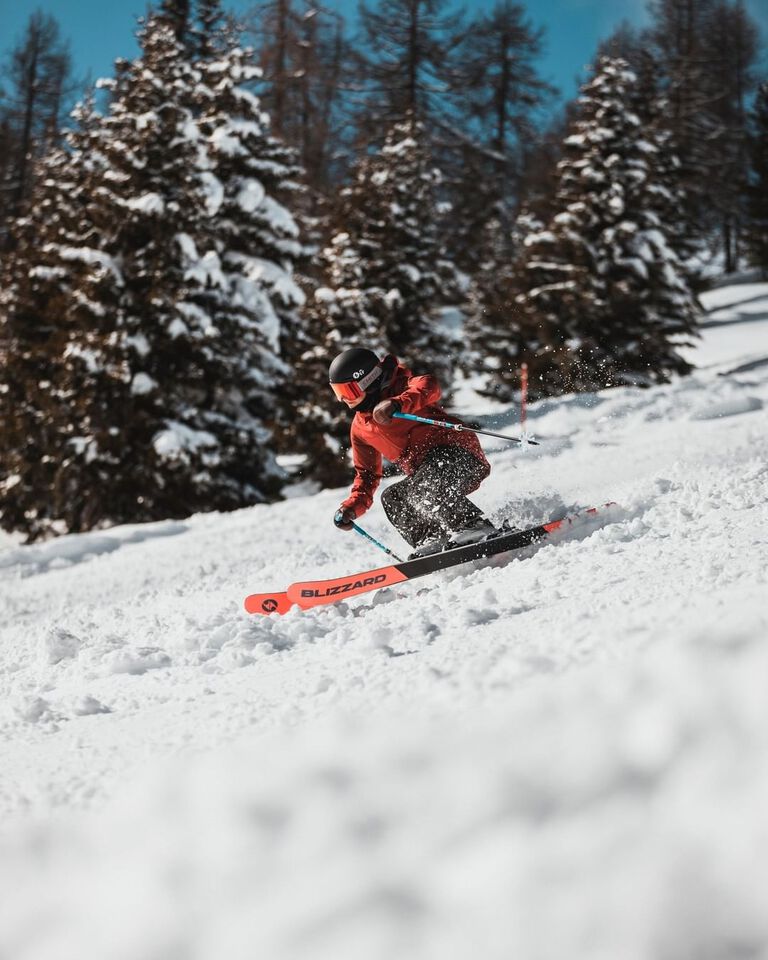
Christy Sports – Ski Buying Guide
HOW TO CHOOSE THE RIGHT PAIR OF SKIS
Choosing the right pair of skis for your needs can make a big difference on the slopes, and our team at Christy Sports wants to help you make an informed decision, whether that is in store or online. Buying skis does not have to be complicated. There are a few important points you should know to help narrow your search and choose the option that is best suited to you. In this buying guide we’ve listed some of the main considerations to help you determine what skis will allow you to perform to the best of your ability.

Ability Level and Ski Length
Ideal ski type and ski length length depend on ability level.
Beginner skiers:
- Softer, more flexible, narrower skis = easier learning.
- Shorter length (chin–nose height) = easier turns + better control.
- Examples: Atomic Bent 90 or K2 Mindbender 90C
Intermediate skiers:
- Ideal ski length = mid-face height.
- Shorter skis will help with easier turns and maneuverability.
- Longer skis allow for more stability at speed, but can be harder to manage.
- Consider choosing skis based on terrain preference or skill goals, such as:
- Moguls/carving performance → narrower all-mountain ski (e.g., Nordica Enforcer 94).
- Freestyle progression + all-mountain skiing → all-mountain twin (e.g., Armada ARV 100).
Advanced/Expert skiers:
- Ski length = full height or taller.
- Longer skis = stability + performance when paired with refined skills and technique.
- Wide range of options: all-mountain “quiver killers” like the Salomon QST 106, Black Crows Atris, or Blizzard Rustler 10, or specialized skis for different disciplines like carving, powder, or park.
Tip: Utilize demo days or our Try Before You Buy program help find best match.

TERRAIN TYPE
Goal: Many skiers want one versatile ski (also known as a “quiver of one”).
Width underfoot is the simplest way to determine a ski's best use case:
- 90–100mm → best all-mountain range; good on groomers + powder.
- <90mm → excels on groomers; poor in deep snow.
- 100–110mm → versatile but best in soft/deep snow.
- >110mm → powder-specific skis.
Flex/Stiffness:
- Stiffer skis → stability at high speeds + variable terrain; suit aggressive skiers. Examples include Nordica Enforcers or Volkl Mantras.
- Softer skis → easier turning, lighter, better for slower speeds + mellow terrain, or for freestyle skiing. Examples include the Atomic Bent 100 or Elan Playmaker 101.
Key tip: Match ski width + stiffness to your ability and terrain preferences.

Ski Construction
Construction basics: Most skis = wood + metal laminate or a composite material(carbon/fiberglass) to construct the core.
With metal laminates:
- Heavier, stiffer.
- Smooth, damp ride.
- Stable at high speeds → favored by aggressive skiers.
Without metal laminates:
- Lighter, more flexible.
- Lively, poppy, easy to turn.
- Less stable at high speeds or in variable snow.
Comparison:
- K2 Mindbender 96C vs. K2 Mindbender 99TI
- Very similar in shape + width. Additional of metal in the 99TI model = different performance characteristics.
Key tip: Metal = stability & power; No metal = agility & playfulness.

SKI PROFILE
Rocker profile = ski shape viewed from the side; affects on-snow performance.
Common all-mountain rocker profile:
- Tip rocker: ski tip curves up from the snow surface → easier turn initiation, better float in deep snow.
- Tail rocker: tail slightly curves up from the snow surface → smoother transition between turns.
- Camber underfoot: middle of the ski bends back up from the snow → edge grip, energetic “pop,” controls turning radius.
Twin tips: Symmetrical tip + tail rocker → ideal for freestyle, skiing switch.
- Example: Armada ARV 94
Powder skis: More tip rocker (sometimes full rocker) → floats in deep snow.
- Example: Atomic Bent Chetler 120
Carving skis: Minimal tip rocker, little to no tail rocker → maximizes edge for firm snow turns.
- Example: Blizzard Stormbird 82
All-around recommendation: Some tip/tail rocker + underfoot camber = versatile for most skiers/conditions.
Shop Top Ski brands
Mens & Womens Size Ski Size Chart
Men's Ski Lengths
| Skier Height (in) | Skier Height (cm) | Expert Ski Length (cm) | Intermediate Ski Length (cm) | Beginner Ski Length (cm) |
|---|---|---|---|---|
| 4'6" | 137 | 140 | 135 | 125 |
| 4'8" | 142 | 145 | 140 | 130 |
| 5'0" | 152 | 155 | 145 | 135 |
| 5'2" | 158 | 165 | 155 | 145 |
| 5'6" | 168 | 175 | 165 | 155 |
| 5'8" | 173 | 180 | 170 | 160 |
| 5'10" | 178 | 185 | 175 | 165 |
| 6'0" | 183 | 190 | 180 | 170 |
| 6'2" | 188 | 195 | 185 | 175 |
| 6'4" | 193 | 195 | 190 | 180 |
Women's Ski Lengths
| Skier Height (in) | Skier Height (cm) | Expert Ski Length (cm) | Intermediate Ski Length (cm) | Beginner Ski Length (cm) |
|---|---|---|---|---|
| 4'8" | 142 | 149 | 139 | 136 |
| 5'0" | 152 | 152 | 142 | 139 |
| 5'2" | 158 | 153 | 146 | 143 |
| 5'4" | 163 | 163 | 153 | 150 |
| 5'6" | 168 | 166 | 156 | 153 |
| 5'8" | 173 | 170 | 160 | 157 |
| 5'10" | 178 | 173 | 163 | 160 |
| 6'0" | 183 | 180 | 170 | 167 |


